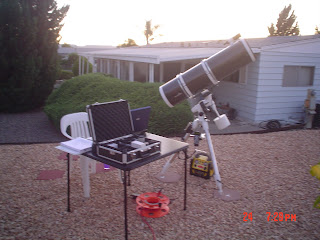I'm starting to use Nebulosity software for my capture process. The moon was full tonight so couldn't capture any nebulas so went for clusters instead. Here's my 1st attempts for both (20 ea 30 second images stacked).

From Wikipedia, the free encyclopedia
Messier 71 (also known as M71 or NGC 6838) is a globular cluster in the constellation Sagitta. It was discovered by Philippe Loys de Chéseaux in 1746 and included by Charles Messier in his catalog of comet-like objects in 1780. It was also noted by Koehler at Dresden around 1775.
M71 is at a distance of about 12,000 light years away from Earth and spans some 27 light years across. The irregular variable star Z Sagittae is a member of this cluster.
M71 was long thought (until the 1970s) to be a densely packed open cluster and was classified as such by leading astronomers in the field of star cluster research due to its lacking a dense central compression , its stars having more "metals" than is usual for an ancient globular cluster, and further its lacking the RR Lyrae "cluster" variable stars that are common in most globulars. However, modern photometric photometry has detected a short "horizontal branch" in the H-R diagram of M71, which is characteristic of a globular cluster. The shortness of the branch explains the lacking of the RR Lyrae variables and is due to the globular's relatively young age of 9-10 billion years. The relative youth of this globular also explains the abundance of "metals" in its stars. Hence today, M71 is designated as a very loosely concentrated globular cluster, much like M68 in Hydra. M71 has a luminosity of around 13,200 suns.

From Wikipedia, the free encyclopedia
Messier 92 (also known as M92 or NGC 6341) is a globular cluster in the constellation Hercules. It was discovered by Johann Elert Bode in 1777 and independently rediscovered by Charles Messier on March 18, 1781. M92 is at a distance of about 26,000 light-years away from Earth.
M92 is one of the brighter globular clusters in the northern hemisphere, but it is often overlooked by amateur astronomers because of its proximity to the even more spectacular Messier 13. It is visible to the naked eye under very good conditions. [2]



























